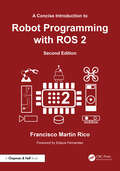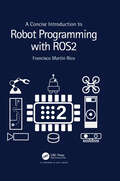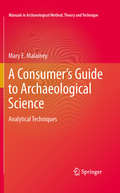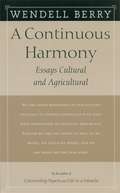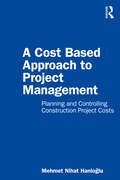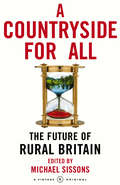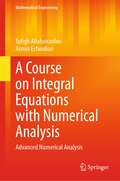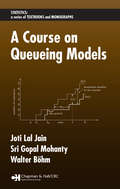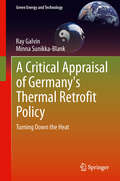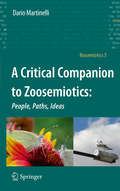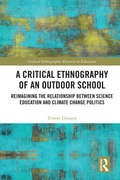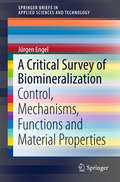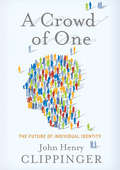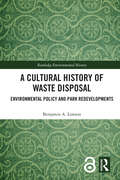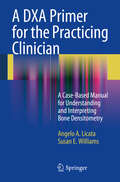- Table View
- List View
A Concise Introduction to Robot Programming with ROS 2
by Francisco Martín RicoA Concise Introduction to Robot Programming with ROS2 provides the reader with the concepts and tools necessary to bring a robot to life through programming. It will equip the reader with the skills necessary to undertake projects with ROS2, the new version of ROS. It is not necessary to have previous experience with ROS2 as it will describe its concepts, tools, and methodologies from the beginning. Uses the two programming languages officially supported in ROS 2 (C++, mainly, and Python) Approaches ROS 2 from three different but complementary dimensions: the Community, Computation Graph, and the Workspace Includes a complete simulated robot, development and testing strategies, Behavior Trees, and Nav2 description, setup, and use A GitHub repository with code to assist readers It will appeal to motivated engineering students, engineers, and professionals working with robot programming.
A Concise Introduction to Robot Programming with ROS2
by Francisco Martín RicoA Concise Introduction to Robot Programming with ROS2 provides the reader with the concepts and tools necessary to bring a robot to life through programming. It will equip the reader with the skills necessary to undertake projects with ROS2, the new version of ROS. It is not necessary to have previous experience with ROS2 as it will describe its concepts, tools, and methodologies from the beginning. Key Features Uses the two programming languages officially supported in ROS2 (C++, mainly, and Python) Approaches ROS2 from three different but complementary dimensions: the Community, Computation Graph, and the Workspace Includes a complete simulated robot, development and testing strategies, Behavior Trees, and Nav2 description, setup, and use A GitHub repository with code to assist readers It will appeal to motivated engineering students, engineers, and professionals working with robot programming.
A Concise Introduction to Traffic Engineering: Theoretical Fundamentals and Case Studies (Springer Tracts in Civil Engineering)
by Raffaele Mauro Marco GuerrieriThis book covers a selection of fundamental topics of traffic engineering useful for highways facilities design and control. The treatment is concise but it does not neglect to examine the most recent and crucial theoretical aspects which are at the root of numerous highway engineering applications, like, for instance, the essential aspects of highways traffic stream reliability calculation and automated highway systems control. In order to make these topics easy to follow, several illustrative worked examples of applications are provided in great detail. An intuitive and discursive, rather than formal, style has been adopted throughout the contents. As such, the book offers up-to-date and practical knowledge on several aspects of traffic engineering, which is of interest to a wide audience including students, researchers as well as transportation planners, public transport specialists, city planners and decision-makers.
A Concise Introduction to the Statistical Physics of Complex Systems (SpringerBriefs in Complexity)
by Eric BertinThis concise primer (based on lectures given at summer schools on complex systems and on a masters degree course in complex systems modeling) will provide graduate students and newcomers to the field with the basic knowledge of the concepts and methods of statistical physics and its potential for application to interdisciplinary topics. Indeed, in recent years, statistical physics has begun to attract the interest of a broad community of researchers in the field of complex system sciences, ranging from biology to the social sciences, economics and computer science. More generally, a growing number of graduate students and researchers feel the need to learn some basic concepts and questions originating in other disciplines without necessarily having to master all of the corresponding technicalities and jargon. Generally speaking, the goals of statistical physics may be summarized as follows: on the one hand to study systems composed of a large number of interacting 'entities', and on the other to predict the macroscopic (or collective) behavior of the system considered from the microscopic laws ruling the dynamics of the individual 'entities'. These two goals are, to some extent, also shared by what is nowadays called 'complex systems science' and for these reasons, systems studied in the framework of statistical physics may be considered as among the simplest examples of complex systems--allowing in addition a rather well developed mathematical treatment.
A Construction Manual for Robots' Ethical Systems: Requirements, Methods, Implementations (Cognitive Technologies)
by Robert TrapplThis book will help researchers and engineers in the design of ethical systems for robots, addressing the philosophical questions that arise and exploring modern applications such as assistive robots and self-driving cars. The contributing authors are among the leading academic and industrial researchers on this topic and the book will be of value to researchers, graduate students and practitioners engaged with robot design, artificial intelligence and ethics.
A Consumer's Guide to Archaeological Science: Analytical Techniques (Manuals in Archaeological Method, Theory and Technique)
by Mary E. MalaineyMany archaeologists, as primarily social scientists, do not have a background in the natural sciences. This can pose a problem because they need to obtain chemical and physical analyses on samples to perform their research. This manual is an essential source of information for those students without a background in science, but also a comprehensive overview that those with some understanding of archaeological science will find useful. The manual provides readers with the knowledge to use archaeological science methods to the best advantage. It describes and explains the analytical techniques in a manner that the average archaeologist can understand, and outlines clearly the requirements, benefits, and limitations of each possible method of analysis, so that the researcher can make informed choices. The work includes specific information about a variety of dating techniques, provenance studies, isotope analysis as well as the analysis of organic (lipid and protein) residues and ancient DNA. Case studies illustrating applications of these approaches to most types of archaeological materials are presented and the instruments used to perform the analyses are described. Available destructive and non-destructive approaches are presented to help archaeologists select the most effective technique for gaining the target information from the sample. Readers will reach for this manual whenever they need to decide how to best analyze a sample, and how the analysis is performed.
A Continuous Harmony: Essays Cultural and Agricultural
by Wendell BerryBerry's second collection of essays was first published in 1972, and contained eight essays, including the seminal "Think Little," which was printed in "The Last Whole Earth Catalogue" and reprinted around the globe, and the splendid centerpiece, "Discipline and Hope," an insightful and articulate essay of instruction and caution.
A Contractor's Guide to Planning, Scheduling, and Control
by Len HolmA MUST-HAVE, PRACTICAL GUIDE THAT CONNECTS SCHEDULING AND CONSTRUCTION PROJECT MANAGEMENT In A Contractor’s Guide to Planning, Scheduling, and Control, an experienced construction professional delivers a unique and effective approach to the planning and scheduling responsibilities of a construction project manager, superintendent, or jobsite scheduler. The author describes the complete scheduling cycle, from preconstruction and scheduling through controls and closeout, from the perspective of real-world general contractors and scheduling professionals. Filled with tools and strategies that actually help contractors build projects, and light on academic jargon and terminology that’s not used in the field, the book includes examples of real craft workers and subcontractors, like electricians, carpenters, and drywallers, to highlight the concepts discussed within. Finally, an extensive appendix rounds out the book with references to additional resources for the reader. This comprehensive guide includes: Thorough introductions to construction contracting, lean construction planning, subcontractor management, and more A comprehensive exploration of a commercial case study that’s considered in each chapter, connecting critical topics with a consistent through line End-of-chapter review questions and applied exercises Access to a companion website that includes additional resources and, for instructors, solutions, additional case studies, sample estimates, and sample schedules Perfect for upper-level undergraduate students in construction management and construction engineering programs, A Contractor’s Guide to Planning, Scheduling, and Control is also an irreplaceable reference for general contractors and construction project management professionals.
A Cost Based Approach to Project Management: Planning and Controlling Construction Project Costs
by Mehmet Nihat HaniogluA Cost Based Approach to Project Management: Planning and Controlling Construction Project Costs introduces early-career architects, construction managers, civil engineers, and facility managers to the essentials of delivering projects on-time and at cost. Drawing on the author’s decades of experience managing marquee building and infrastructure projects around the world, this primer offers busy professionals a crash course in budgeting, cost estimating, scheduling, and cost control. Chapters break down the details of cost elements, structuring project costs, and integrating budget with schedule, providing novice project managers with the key skills to plan and execute construction projects with confidence and precision. Features: Illustrates the principles of project management and the essentials of cost planning and control with easy-to-understand examples from the construction industry Includes step-by-step details of project planning, cost estimating, and management processes Offers clear, cost-based methods for defining scope, preparing bids, and planning for contingencies, as well as monitoring progress and determining when to take remedial action Contains a user-friendly guide to project management acronyms and terminology Provides sample construction schedules, budgets, and progress report forms An ideal resource for self-study, on-the-job training, or courses in construction, architecture, or civil engineering project management, A Cost Based Approach to Project Management makes a worthy addition to the aspiring project manager’s reference shelf.
A Countryside For All: The Future of Rural Britain
by Michael SissonsThe rural fuse has been lit. The countryside is tinder-dry. Post offices and banks, shops and schools are closing. Farmers are going out of business. Houses are becoming unaffordable as prices soar ad poverty grows. Pollution and over-exploitation are destroying landscapes. Many rural communities are on the verge of collapse. Some fear the foot- and - mouth crisis will prove to be the last straw. This book offers disturbing evidence of the background to the crisis.A Countryside For All is a rallying cry for action, pointing ways towards a presciption for the future. This volume tackles many of the issues in a variety of new and original ways. Possibly the most controversial and radical call is for the creation of a Department for the Countryside, with a Secretary of State for the Countryside- who would be responsible for setting a coherent set of policies to reverse the decline of rural Britain.This timely book outlines the main problems facing the countryside, and starts to bring together a balanced range of proposals. Thought-provoking, filled with common sense, often controversial but always fascinating, it points the way forward for the countryside, and for town and country as a whole.
A Course on Integral Equations with Numerical Analysis: Advanced Numerical Analysis (Mathematical Engineering)
by Tofigh Allahviranloo Armin EsfandiariThis book suggests that the numerical analysis subjects’ matter are the important tools of the book topic, because numerical errors and methods have important roles in solving integral equations. Therefore, all needed topics including a brief description of interpolation are explained in the book. The integral equations have many applications in the engineering, medical, and economic sciences, so the present book contains new and useful materials about interval computations including interval interpolations that are going to be used in interval integral equations. The concepts of integral equations are going to be discussed in two directions, analytical concepts, and numerical solutions which both are necessary for these kinds of dynamic systems. The differences between this book with the others are a full discussion of error topics and also using interval interpolations concepts to obtain interval integral equations. All researchers and students in the field of mathematical, computer, and also engineering sciences can benefit the subjects of the book.
A Course on Queueing Models
by Joti Lal Jain Walter Böhm Sri Gopal MohantyThe application of engineering principles in divergent fields such as management science and communications as well as the advancement of several approaches in theory and computation have led to growing interest in queueing models, creating the need for a comprehensive text. Emphasizing Markovian structures and the techniques that occur in differen
A Crack in Creation: Gene Editing and the Unthinkable Power to Control Evolution
by Jennifer A. Doudna Samuel H. SternbergA trailblazing biologist grapples with her role in the biggest scientific discovery of our era: a cheap, easy way of rewriting genetic code, with nearly limitless promise and peril. Not since the atomic bomb has a technology so alarmed its inventors that they warned the world about its use. Not, that is, until the spring of 2015, when biologist Jennifer Doudna called for a worldwide moratorium on the use of the new gene-editing tool CRISPR—a revolutionary new technology that she helped create—to make heritable changes in human embryos. The cheapest, simplest, most effective way of manipulating DNA ever known, CRISPR may well give us the cure to HIV, genetic diseases, and some cancers, and will help address the world’s hunger crisis. Yet even the tiniest changes to DNA could have myriad, unforeseeable consequences—to say nothing of the ethical and societal repercussions of intentionally mutating embryos to create “better” humans. Writing with fellow researcher Samuel Sternberg, Doudna shares the thrilling story of her discovery, and passionately argues that enormous responsibility comes with the ability to rewrite the code of life. With CRISPR, she shows, we have effectively taken control of evolution. What will we do with this unfathomable power?
A Critical Appraisal of Germany's Thermal Retrofit Policy: Turning Down the Heat (Green Energy and Technology)
by Ray Galvin Minna Sunikka-BlankGermany is seen as a leader in thermal retrofit policy and practice, but how effective is its approach? A Critical Appraisal of Germany's Thermal Retrofit Policy examines this policy in context and assesses its effectiveness. It finds that technical constraints and the costs of retrofitting reduce the rate of progress, while planning underestimates the influence of user behavior in the form of rebound and prebound effects. A key finding is that savings can be maximized within a policy that understands the actual behavior and motivation of households, the area where most energy savings are already taking place. The book suggests a new policy paradigm that would encourage a better balance of partial and comprehensive retrofits, utilizing household behavior changes based on a better understanding of fuel saving motivation and fuel price elasticity. In this approach, the thermal building regulations would be made more flexible so that policymakers would: - Promote partial, transitional and cost-optimal retrofits, which are more certain to pay back through fuel savings if they are appropriate to building typology and homeowner budgets. - Promote comprehensive retrofits for reasons other than economic gain, focusing instead on the comfort and environmental benefits of energy-efficient homes. - Invest more heavily in educating households to heat economically, learning from the prebound effect so as to maximize the utility of the homes they currently occupy, and base payback time calculations on actual consumption. The results and findings of this book would be of interest to policymakers, researchers and graduate students alike.
A Critical Approach to International Water Management Trends
by Christian Bréthaut Rémi SchweizerThis edited volume provides a critical discussion of particular trends that are widely recognised to influence water management by comparing them with what is actually happening in the field. Among others, these trends include water security, adaptive or integrative management, and the water-energy-food nexus, which are often presented as essential means to reaching more sustainable and resilient water use. However, the extent to which these trends have managed to structure concrete practices in water management remains uncertain. Informed by empirically grounded research, each chapter of this work engages with a particular approach, concept or theory. Together, they provide a nuanced picture of trends in water management that require universal remedies and global norms.
A Critical Companion to Zoosemiotics: People, Paths, Ideas (Biosemiotics #5)
by Dario MartinelliA critical companion of zoosemiotics is the first attempt to systematise the study of animal communication and signification through its most important and/or problematic terms and concepts, and its most representative scholars. It is a companion, in that it attempts to cover the entire range of key terms in the field, and it's critical, in that it aims not only to describe, but also to discuss, problematise and, in some cases, resolve, these terms.
A Critical Ethnography of an Outdoor School: Reimagining the Relationship between Science Education and Climate Change Politics (Critical Ethnographic Research in Education)
by Tristan GleasonBy using critical ethnographic research to explore the practices and policies that sustain a residential outdoor school in the US, this volume problematizes the relationship between science education and climate change politics in the United States. Weaving together empirical data from field work with theoretical resources spanning the sciences and humanities, this volume demonstrates how community activism, political alliances, and policy change have guaranteed the survival of an outdoor school in Oregon. This example enables artful re-examination of the relationship between science education, politics, and policy more broadly, as well as the relation of science education to climate change politics in particular. Gleason ultimately reconstructs science education towards epistemic and ontological pluralism, and illustrates how critical ethnographic research can instigate a reimagining of the relationship between curriculum and how we relate to the world. This text will benefit researchers, academics, and educators in higher education with an interest in the philosophical underpinnings and implications of science education, environmental education, and educational policy more broadly. Those specifically interested in critical ethnographic research will also benefit from this book.
A Critical Survey of Biomineralization
by Jürgen EngelThis monograph provides a comprehensive and up-to-date approach on biomineralization. The topical focus of the book lies on the question of how matrix proteins and cells catalyze and regulate mineralization in organisms. Recent advances in the understanding of biomineralization help to better understand biomaterials, in particular their mechanical properties. The target audience primarily comprises practitioners and research experts in the field, but the book may also be beneficial for graduate students.
A Cross-Disciplinary Exploration of STEM: Selected Works From the XI Workshop on R&D+i and the 3rd International Workshop on STEM at EPS (Springer Proceedings in Materials #85)
by Yadir Torres Manuel Felix Estela Peralta Ana M. Beltrán Diego F. Larios MarínThis book compiles selected works from a workshop promoting collaboration between academia, industry, and society by engaging educators, researchers, technicians, and students. It highlights advancements in Artificial Intelligence, Additive Fabrication, Smart Manufacturing, and 3D Printing. Key topics include circular economy, bio-inspired sensory fusion systems, computer-aided design, and machine vision in manufacturing. Themes also explore industrial robotics, neuromorphic systems, product design, efficiency management, and automatic control in manufacturing. By integrating STEM, industrial and environmental chemistry, and sustainable technologies, this book underscores innovative approaches for future industrial and societal challenges.
A Crowd of One: The Future of Inidvidual Identity
by John HenryGreat leaps forward in scientific understanding have, throughout history, engendered similar leaps forward in how we understand ourselves. Now, the new hybrid disciplines of evolutionary biology and social physics are making the next leap possible-and fundamentally altering our notions of individual identity. If identity is a fact not derived from within the individual, but conferred on an individual by a group, or network, a host of assumptions about how governments work, how conflicts arise and are resolved, and how societies can be coaxed toward good are overturned. John Clippinger brilliantly illuminates how the Enlightenment itself-the high point of individual assertiveness-was a product not just of a few moments of individual inspiration and creativity, but rather of a societal shift that allowed innovation and creativity to flourish. Michelangelo owes quite as much to the circumstances of the Renaissance as the Renaissance does to the work of Michelangelo. Now, the digitalization of society, which affects all of us already, allows new insight into these questions: What does it require for societies, organizations and individuals, to thrive? Who decides who you are? How can happiness be shared and spread? Who can you trust?
A Cultural History of Waste Disposal: Environmental Policy and Park Redevelopments (Routledge Environmental History)
by Benjamin A. LawsonThis book offers a historical analysis of landfill sites in New York City, Greater Toronto, and Greater Tel Aviv, and uses them as case studies to emphasize the international and global scale of issues concerning waste disposal and park redevelopments.New York, Toronto, and Tel Aviv are currently redeveloping giant landfills into parks to much fanfare. The park redevelopments may be seen as an attempt to erase or assuage the decades of problematic waste-disposal policy that led to the creation of such large landfills. Booster rhetoric underscores this point, such as promoting how the parks will be a “green lung” for the city. This book contextualizes these redevelopments by offering a historical analysis, providing a greater understanding of the past, current, and future potential issues. It goes on to analyze the language and media coverage surrounding former waste sites becoming park redevelopments, including how cities use art to promote their image and gain cultural relevance. By engaging with both the works of waste historians and literature on waste and discard studies, the book provides theoretical models for analyzing the role of power in municipal systems, as well as human and ecological impacts on waste. It concludes with an analysis of the features necessary for landfill parks to be successful. This book will be useful for scholars, researchers, and academics studying waste studies, the environment, cities, and sustainable development, as well as for policymakers and environmental/eco artists.
A Cup of Coffee and the Ocean: The Basics of Ocean Dynamics
by Sung Yong KimThis book introduces various, easily understandable examples of fluids encountered in daily life. It describes the characteristics of these fluids, starting from a cup of coffee, a familiar small-scale fluid, to the vast ocean—one of the largest-scale fluids on Earth. Understanding the principles of fluids and their motion has long been complex and challenging. However, grasping these fundamentals opens doors to deeper exploration and discovery. This book engages middle and high school students, undergraduates, and curious readers in exploring the ocean&’s vast possibilities. Cartoons and simple language make the concepts more accessible, helping readers not only understand fluids but also gain valuable safety insights related to the ocean.
A Curious Mind
by Andrew MatthewsBenjamin Franklin was often curious about the world around him. Utilizing observation and testing of the scientific method, he was able to invent many new items that improved the world for others. These inventions include his famous bifocal glasses, lightning rod, and even a long extension arm.
A Curious Robot on Mars!
by Bethany Straker James Duffett-SmithFar off into space--186 million miles to be precise--a fearless robot rover travels all by his lonesome. He is on a crucial mission from Earth, eagerly seeking to answer the much-anticipated question: Does life exist on Mars? But there is nothing to be seen on this planet except miles of rocks. He loses support from mission control and finds himself alone and cut off from civilization. But the curious little robot is resilient! After noticing a flash of light shining brilliantly through the crack of a rock, he instantly realizes his mission is far from over. He slowly inches towards the edge, but then suddenly falls perilously into the darkness! What will he discover?Bethany Straker's vibrant illustrations accompany James Duffett-Smith's suspenseful tale of discovery and hope. A Curious Robot on Mars! will motivate any and all readers to strive for one's ambitions--and most importantly, to always be curious!
A DXA Primer for the Practicing Clinician: A Case-Based Manual for Understanding and Interpreting Bone Densitometry
by Angelo A. Licata Susan E. WilliamsDespite public perception, osteoporosis remains a widespread, devastating disease, and a very serious and costly public health threat. Early detection and treatment must be a priority for primary health care providers. Dual-energy X-ray absorptiometry (DXA) is the principal x-ray technology used to diagnose osteoporosis in its early, asymptomatic stages, to assess treatment efficacy, and to guide treatment decisions. It remains the gold standard today. A DXA Primer for the Practicing Clinician: A Case-Based Manual for Understanding and Interpreting Bone Densitometry is developed around real cases of patients' DXA measurements. The content is derived from presentations given by the authors at a national society training course and exemplifies not only the complete body of education provided through these lectures but the full range of previously undiscussed nuances as well. This practical, easy-to-read title provides the day to day problems of DXA usage that new users may encounter and that training courses do not have time to provide in detail. The central focus of the book is the presentation of what is normal and what is problematic in the use of DXA, depicting various scenarios with real case histories of patients, their corresponding DXA images and the data that explain the problems. Unique in approach and presentation, this case-based manual will be of immense value to all practitioners -- and students - interested in providing optimal diagnosis and treatment of osteoporosis.
